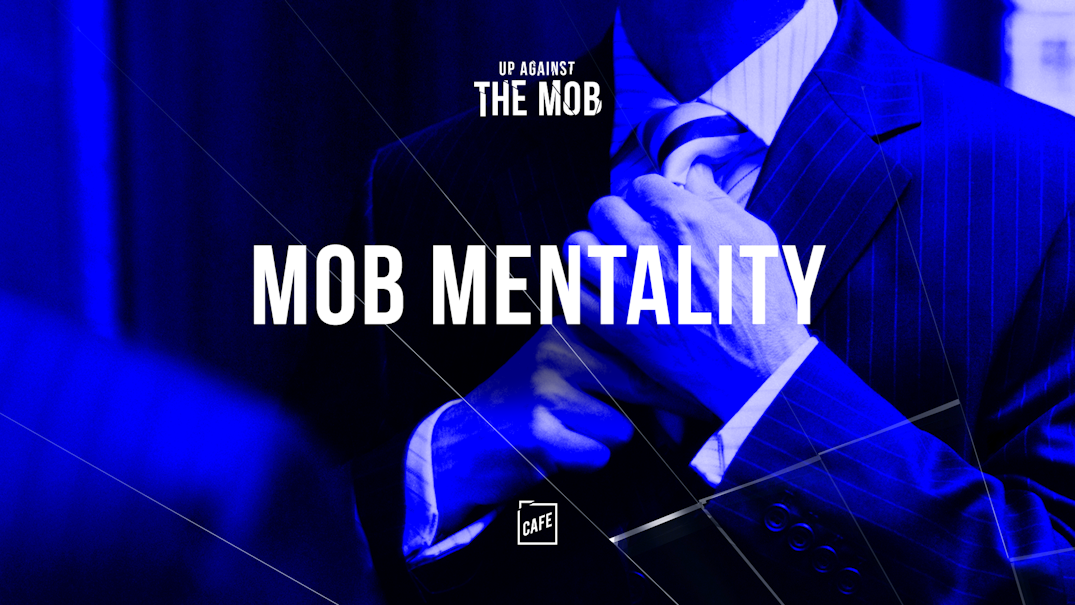Elie Honig:
Before we start, just a heads up. As you might expect, there’s some violence and adult language in here. So if you got kids around, you may want to throw on some headphones first, thanks. From Cafe and the Vox Media Podcast Network, I’m Elie Honig and this is Up Against The Mob. The first real mobster I ever tried was a guy named Ciro Perrone. Now Ciro was a throwback old school. He was 80 years old when we tried him in federal court in Manhattan, and he was a straight up lifelong gangster. Ciro had been a made guy with the Genovese for at least 50 years.
Elie Honig:
Now Ciro had style. He wasn’t a double breasted suit, tie, pocket square, and hair dye type, but he had his own look. Always sharp with a bit of flare balding, but neat gray hair, always in place. Nice shoes polished. He’d sometimes wear a blue leather jacket, more fashion forward than garish even at trial in front of the jury. Word was Ciro had once been a skilled ballroom dancer in the local dance halls in Ozone park, Queens, where he grew up. He still carried himself with a grace of movement even into his eighties.
Elie Honig:
And Ciro was always, always tan. We marveled at his ability to stay bronze, even living in New York city in the middle of winter. When the FBI agents would do surveillance of Ciro in Queens, they’d often see him sitting outside holding one of those foil sun reflector things under his chin, even in November and December. Over the years, Ciro quietly did very, very well for himself. Mostly operating from a modest social club in Queens while John Gotti was out printing for the cameras and the tabloids, Ciro was keeping his business quiet under the radar. When we prepared to arrest Ciro, I actually got a copy of his rap sheet.
Elie Honig:
It’s the strangest rap sheet I’ve ever seen. I had never seen one quite like it, and I haven’t since. His most recent conviction was for burglary in 1955, when he was in his twenties in the over 50 years since then, up until we arrested him, nothing. As we built the case against Ciro, we put a bug meaning a recording device in his table at Don Pepe’s restaurant in Queens, the back left corner table, where he ate every Tuesday and Thursday night with his crew. Now Ciro held court at those dinners at Don Pepe’s restaurant. He had a raspy voice, not loud, and he had a compelling knack for jokes and storytelling. He was funny. He was self effacing. He could break chops as they say, he was simply put charming, charismatic, even likable at times. When we took the case down, we started out with 25 defendants.
Elie Honig:
They pled guilty one by one until the last batch. Ciro and three of his closest guys. Now he was old school in every sense, as the mob world changed around him, Ciro stayed true to the core rules, especially the mob’s first rule, omerta or silence. His attitude was you can indict me, but I’ll never say a word, I’ll never admit anything, I won’t even take a plea. That was my first mafia trial. It was long and complicated in a way. There wasn’t your usual violence or murder the kind of thing juries easily understand and care about. This case was about racketeering, extortion, loan sharking, gambling, the kind of things that almost seemed soft to a jury and routine on the streets of Ozone Park, Queens. No real violence, no blood, just intimidation and cash. So it was a tough case to prosecute, but we had some strong evidence on the tapes, the ones we made by bugging Ciros back corner table at Don Pepe’s restaurant.
Elie Honig:
As we played those tapes, I watched the jurors reactions, not much at first, but soon I started to notice. The jury didn’t seem offended by Ciro or repulsed or scared. They almost seemed to enjoy listening to him in a way. They even smiled or laughed sometimes at his jokes or his malapropisms. And it hit me, we had a problem on our hands. One evening after trial let out, I turned to my trial partner and FBI agents on the case and I said, “the jury’s falling in love with him.” Sure enough, the jury had no appetite to convict Ciro, they hang, meaning they could not reach a unanimous verdict and we’d later learned that 10 of the 12 jurors wanted to acquit him, find him not guilty while just two held out for conviction. We came very close to losing the case. When a jury hangs, you can retry the defendant and we decided to give it another shot on Ciro.
Elie Honig:
He was too powerful, he’d gotten away scot free living gangster’s life for too long to just walk away. But this time we made a key adjustment. We cut down on those tapes from Don Pepper’s restaurant. We took out some of Ciro’s more colorful stories. We cut out as much of the banter and the joking as we could. And we left the jury with Ciro’s dry conversations and admissions about his crimes. We asked ourselves out loud, “does he sound too likable in this one?” I watched the jury again, this time, the second trial and this time they didn’t seem exactly horrified by Ciro’s words, but they also didn’t seem to fall for him either. We had stripped Ciro of his mafia charm. While after just a few hours of deliberation, that second jury convicted Ciro unanimously on all counts, a nearly opposite result from the first trial. Little story I’ll always remember from the day that second jury convicted Ciro. After the judge took the verdict, he thanked the jury for their service and dismissed them. Now everyone knew what would happen next.
Elie Honig:
We, the prosecutors would make a motion to have the judge remand Ciro, that is send him to jail, he had been out on bail up until then. This was a standard move whenever a defendant got convicted. So the judge said, let’s take a five minute break and we’ll come back and discuss the defendant’s bail status. I left the courtroom and went to the bathroom. And when I walked back into the courtroom, Ciro was standing there with his lawyer right by the back door. Now I had never spoken directly with Ciro. Sometimes prosecutors and defendants strike up an odd, almost friendly banter during trial, not in front of the jury, but just during breaks.
Elie Honig:
But Ciro and I never spoke a word directly to one another and he knew what was about to happen. He was 80 years old and looking at several years behind bars. These could have been his last few minutes on earth as a free man. As I walked back through the doors of the courtroom, I could tell Ciro was waiting and wanted to say something to me. So, I slowed down and turned towards Ciro and his lawyer and Ciro said in that distinctive gruff, but not loud voice. “Hey kid, you did go no hard feelings.” Sure enough, a few minutes later, the judge sent Ciro to federal prison and eventually the judge sentenced him to five years behind bars. From time to time after that, I wondered would Ciro die in prison or would he make it out for the end of his life? Turns out he served all his time, he did his five years minus the small standard reduction for good behavior and he got out. He went home to his Queens apartment with his wife, lived another few months and then passed away.
Elie Honig:
That was Ciro, old school to the end. Never complained did his time and showed everyone that he could live through it. So here’s my confession, and you can probably tell from what I’ve been saying, like the jury in that at first trial, I too was a bit charmed by Ciro Perrone. I found him charismatic, funny, even compelling at times. I was under no illusion. I knew this man spent his entire career 50 plus years doing nothing but committing crimes and I’m sure he hurt people along the way, but I couldn’t help myself. The same way you watch the Sopranos and you root for Tony Soprano or the godfather and you root for Michael Corleone, I developed a certain appreciation for Ciro Perrone. I know, it’s not rational, it’s not sensible, but we’re all human. So why does this happen? Why do we naturally tend to root for, to like, to be charmed by mobsters? And why mobsters in particular? Is it something about them, their lifestyle?
Elie Honig:
What is it that tends to draw us in? And what does that say about us? My guest today is Maria Konnikova. Maria is an author and a journalist with a doctorate in psychology, and she specializes in delving inside the mind of the criminal. What makes a criminal tick and how do we relate to the lawbreakers among us? She’s written two New York times bestselling books, both focused on human psychology and criminality. And she has studied and written about a question that always perplexed me. Why do we admire mobsters? Maria Konnikova welcome.
Maria Konnikova:
Thank you so much for having me, Elie.
Elie Honig:
Okay. So, I want to start with a question that I think may give us a little bit of an insight into your mind. How did you become so interested in the mind of the criminal?
Maria Konnikova:
Oh my God. It’s such a funny question that I’ve been asked by my parents as well because it’s definitely something that’s accompanied me for quite some time. And I’m not quite sure, I’ve always been interested in the exceptions, in what the exceptions say about us. It actually it’s why I studied what I did in psychology. I looked at individual differences, what makes us different and what are kind of the quirks of behavior, because I think that we can really learn a lot from that just like you learn a lot about health from studying specific diseases and how things go wrong and what are some of the genetic mutations that can go wrong and suddenly you learn so much about when it’s going right. And when I was in college and looking at psychology, I ended up taking this class with the law school on serial killers, on the psychology of-
Elie Honig:
What a class.
Maria Konnikova:
… of serial killers. It was amazing, I loved it. So it’s something that I’ve always had a fascination for. I’m very interested in the criminal mind.
Elie Honig:
There’s something very interesting about these outliers and this sort of self-contained culture. So, let me ask you then. Why is it that we as a society admire mobsters? And when I say mobsters, I mean, your sort of typical Italian, what we call Cosa Nostra New York city, New Jersey based mobster. What is it about the mafia in particular that has such a hold on the public imagination?
Maria Konnikova:
So I think it’s multifold. And I think if we focus on the Italian mafia in the United States, you end up admiring them because at the beginning they were actually pretty helpful. And if you look at when the mob became kind of powerful in the US, it happened during prohibition where you had the Volstead Act and all of a sudden, all of these disparate individuals, all of these small time players banded together and were able to provide a service that people desperately wanted and people wanted to drink and these were people who actually gave that to you, and who figured out a way around it, and you couldn’t get good alcohol, but they could give it to you, and they started providing clubs and doing all these speakeasies. And so, they were almost heroes. So I do think that even after kind of prohibition was over and was repealed, I think that image, that association definitely helped set the tone for the 20th century.
Elie Honig:
It’s funny to hear mobsters described as helpful. I’ve heard a lot of adjectives, helpful I think is a first. And that’s interesting historically. That’s prohibition is a long time ago. But what has sustained the popular fascination with mobsters in the years since then?
Maria Konnikova:
So I think part of it is that, who they are. So in the US, the most powerful mafia historically, at least, has been Italian American, then some Irish and then you have people obviously like Arnold Rothstein, like Meyer Lansky who are Jews, but for the most part a lot of the big figures, a lot of the people we know about were Italian. And so I think that actually allowed for several interesting things to happen. And it’s hard to think about it right now, but at the time, Italians weren’t quite American. They were still other. They came with their loud accents and their hands and their boisterous families and all these different cultures and traditions and their different language. So they were other, so you were able to kind of create a distance between them and you, but on the other hand, and I think that this was helped by the media.
Maria Konnikova:
They actually seemed at least to have values that were quite American, family loyalty and things like that. And I think that people… it was very easy to see the mafia as kind of an organization that was criminal, yes, but at least they have this honor code, at least they have this very honorable way of comporting themselves. At least they honor women and children. They go to church every Sunday. They are good people in that respect, they won’t harm a female, they won’t harm a child and all of these things, I think helped people on the one hand say, “oh, well, at least they have this code and they’re not like me. So I’m not afraid that my kids are going to join the mob. I might be afraid that my kids will do something else and be involved in some other criminal activity, and I’m not going to glamorize that.
Maria Konnikova:
I’m very scared I don’t want my kid doing drugs or whatever it is, but my kid’s not Italian or Irish or whatever it was, That’s not them, so that’s okay, It’s not going to touch me. And so it’s easy then to put these crimes in a psychologically removed light.
Elie Honig:
Right. And that’s a concept that you refer to, I think, as psychological distancing, right? Meaning this notion that the mob sort of only, I guess, recruits their own, but only in a way hurts their own. I mean, something that always used to make me laugh a little bit was when you’re talking to a mobster, when I was as a prosecutor, they would refer to people as sometimes as civilians. So they would say, we didn’t mess with that guy because he was a civilian or they would sometimes say a legit… I’d say civilian as opposed to a mobster. But there is that notion of separation. And so how do you think that sort of leads to us having this romanticized view of mobsters and who they are?
Maria Konnikova:
The psychological notion of psychological distance, and that’s not my term. It’s a term that came from Yaacov Trope who’s a psychologist at NYU. And it just means that we’re kind of removed mentally from something, and this can be a person, it can be an event, it can be a time period. And over time naturally, things soften, everything will looks great in retrospect. If you just do mental exercise of thinking, how were your summers back when you were a boy?
Elie Honig:
Yep. They were great.
Maria Konnikova:
Weren’t they wonderful?
Elie Honig:
Yeah.
Maria Konnikova:
Weren’t they ideal?
Elie Honig:
And very ideal. I just… yeah.
Maria Konnikova:
Exactly. And then what about 15 years ago? What about 10 years ago? What about five years ago? The closer you get in time, the more concrete detail you can remember and the less rosy the details, but in the moment you can see everything, you can see kind of all of the ups and downs, but then when you go further away, when you’re more distant, it becomes easy to kind of romanticize it. And a lot of the times, all of the bad details are kind of eliminated, good old days. Right. I think it’s a good thing. Most of the time we would not be very happy people if we always just dwelled on the past. And in the moment though, you can actually also acquired that exact same kind of nostalgic glow.
Maria Konnikova:
And that happens when there’s enough distance between you and the phenomenon that you’re thinking about that you can’t personally imagine yourself in that situation. And so, it’s not just the mob, but most people aren’t thinking, “oh, I could be involved in this crime family.” And so you can glamorize almost anything if you’re not in it. We have glamorized warfare before when there was no draft. The moment there’s a draft that glamor goes away very quickly because all of a sudden it can apply to you. You glamorize almost anything, let’s go camping and live off the lam Let’s be thorough, let’s live deliberately. Then you actually go and live deliberately and you realize there’s no running water and no heat and no toilet and you very quickly stop living deliberately.
Maria Konnikova:
So the moment you’re actually in it, it can very much change or the moment you’re threatened with it. So it’s very interesting. It’s this filter. Can this ever apply to me or not? And if you come with the conclusion that no, it can’t, no, I will personally not be affected, then all of a sudden you have this ability to glamorize it should you choose to do so. And I think the mafia is actually like that because we love thinking, “oh, they have these wonderful honor codes and all these things.” And like I said, they come from a background that we can understand, but we are not going to be threatened by them, so we can glamorize them and have that sort of nostalgia in the moment in a way that we can’t for other criminals because if you’re talking about a criminal who can actually affect you, you can really put yourself in that situation.
Maria Konnikova:
I don’t think anyone would romanticize a burglar who could actually come into your home. All of a sudden that’s scary, but maybe a Robin hood, someone who only steals from the rich to give to the poor and would never steal from you. You can glamorize that because it doesn’t apply to you. And I think that for a very long time, people were under the impression that the mob couldn’t touch them because they only touched their own.
Elie Honig:
It’s so interesting. And I’m glad you validated an anxiety that I always used to live with as a prosecutor, which is, I now know called psychological distancing but sometimes it was hard to scare a jury. You want your jury looking at this guy and being scared, but there would be this separation in a way that wouldn’t be there when you were trying a home invasion crew, or a drug crew. So I feel validated now in worrying about… psychologically validated.
Maria Konnikova:
It’s so true. You just see it so many times. The moment that someone puts themselves in a situation, their perspective changes completely. And if you think that can never be me, that distancing can lead to all sorts of things. It can be glamorizing in the sense of the mob, and it can also be, you can actually become very kind of cold and unable to feel empathy. There’s work by Susan Fisk at Princeton, who shows that when we feel psychological distance from people, we often actually become much worse human beings. When we look at the elderly, for instance, or the homeless, those are two populations that oftentimes get a little bit marginalized because no one wants to see themselves as old and everyone thinks so that can’t possibly be me. And so that can actually lead to callousness. So it can lead to a lot of very different emotional outcomes, glamorizing it is one of them, but it can go in a lot of different directions.
Elie Honig:
And you also talked about this notion of the code, the rules, right? They have-
Maria Konnikova:
Omerta.
Elie Honig:
When a guy gets made… omerta, exactly. When a guy gets made, when they do the actual ceremony and prick his finger with a needle, they give them the rules. And I think there’s an interesting psychological phenomenon happening there in the way we look at this group that has a defined set of rules. Now, granted in my experience, those rules are broken anytime it’s convenient or profitable to the mob. But tell us about the role of rules and actually, what are some of the rules that you’ve become aware of that exist in the mob and maybe we’ll compare notes.
Maria Konnikova:
There’s this notion that you have a code, and once you are made, once you’re part of the group, you follow that code. There’s kind of your in group, that’s your new family, they’re family, this is your primary loyalty now. This is your family, this is your blood. You are now part of this for life. And just like, you can’t leave your family because you can’t change your blood even if you really, really, really, really want to, you can’t leave the mob, once you’re in it, you’re in it and you can’t leave at any point. You’re not allowed to change your mind. It’s something that is very literal. And there’s a notion that comes with rules. You have loyalty, you don’t betray your family. You trust each other, you guys are the thing that you’re loyal to. There are oftentimes, and it depends, I think, on the mob, and it depends on the specifics of your organization. There are often rules about when and where you can kill someone.
Elie Honig:
Sure, 100%.
Maria Konnikova:
And how you can do it. And in front of whom you can do it, and in front of whom you can’t, and what’s an acceptable casualty, and what’s not an acceptable casualty. There are lots of rules governing that.
Elie Honig:
Yeah. And I’ll tell you something that always struck me as so interesting about these rules. There’s a set of standard rules that they give them when they’re sworn in, like you said, this is your family now, I don’t care if your father’s on his deathbed, if we call you, you come. All of those, no drugs, no dealing drugs, although they break that all the time, all the big ones, but even like lawyers, the way lawyers have our written rules, and then we have cases arguing about the gray area, they would have these intellectual arguments. For example, if somebody flips, cooperates with the government, does that mean that we now have an open slot to make a new guy or not?
Elie Honig:
And they would go back and forth. I mean, they might as well be written judicial decisions on this. Let me ask you a little bit more of a base psychological question here. Is there something about just the lifestyle, the money and the food and the clothes and the restaurants and the cars, the glamor of it that’s unique to the mafia and the way we perceive them.
Maria Konnikova:
Sure. I mean, I don’t think it’s unique to the mafia. I think you see that with a lot of gangs and kind of being in the hood, being made in the hood which is not quite the mob, but it’s similar. I think that there’s definitely a glamor that comes with having money. And with the notion that you don’t actually have to work a nine to five job in order to get that money. Because I think a lot of people rebel, they say, “I want to be my own man or my own woman. I don’t want to go to the office. I don’t want to do this. I don’t want to do that.” And this offers you a way to get rich quick, so to speak and easy. And people obviously don’t realize that it’s not really like that, it’s hard work like anything, It is a job.
Elie Honig:
Oh totally.
Maria Konnikova:
And it’s actually a much harder job than a lot of others.
Elie Honig:
Totally.
Maria Konnikova:
The funny thing is… So, my new book is about my time as a professional poker player. And I entered the world of poker for the book. I’d never really played before and ended up becoming good, becoming a pro and actually a lot of the same glamor, So to speak, comes to poker. People think it’s very easy and they think that they can make a lot of money and they think that they’re going to be flying in private jets and that it rains cash, it doesn’t, it’s very hard and it does not rain cash. But it’s very funny, I think you see a lot of the same perceptions. People are just drawn to anything that looks like a good bargain in the sense of I’m going to get wealthy and I don’t have to work that card.
Elie Honig:
The thing that jumps out to me is a word that I use to describe what real mob life is like, is a word that people use in the poker context, which is the grind. It’s a grind, right?
Maria Konnikova:
Yes. It is.
Elie Honig:
I mean, people see the Phil Iveys in poker and they see the John Gottis-
Maria Konnikova:
Exactly.
Elie Honig:
… in the mob and think that’s what it’s going to be like. But for 99%, even if made guys in the mob, it’s a grind, they work not nine to five, but terrible hours. They wake up at noon and they’re out all night. And a lot of them are struggling. A lot of them are scraping for any little scam they can get by and poker, long hours at the table, similar to poker, also one of the reasons I think poker really became this subject of popular fascination is the media. The movies that came out the coverage on ESPN, Rounders.
Speaker 3:
No Limit Texas Hold’em is the Cadillac of poker. Each player is dealt two cards face down, five cards are then dealt face up across the middle. These are community cards. Everyone can use is to make the best five card hand. The key to the game is playing the man, not the cards.
Elie Honig:
To what extent do you think media, Goodfellas, Sopranos, Godfather, Donnie Brasco on down the line have caused the public fascination with the mafia or is there a chicken in an egg thing? Are we fascinated with the mafia because of the media or do we create these movies because we’re fascinated.
Maria Konnikova:
I think there’s a bit of a chicken and egg, but I do think that media was really important early on. So, you had Mario Puzo’s, The Godfather actually very early on in the life cycle of the public perception of the mob. And I think the fact that he wanted to focus on this and that he did it in the way that he did it, and then that the movie became such a phenomenon after the book. And the book by the way was a phenomenon before the movie. So we’re talking, now we’re going back in time and I think that that really did help. I mean if you see the don as Marlon Brando, I mean, that’s useful to thinking, oh, this is a good thing.
Speaker 4:
Someday, and that day may never come, I’ll call upon you to do service for me, but until that day, accept this justice as a gift on my daughter’s wedding day.
Maria Konnikova:
And the fact that these were brilliant book, brilliant movie. The fact that this was really well done, I think really helped. And then after that, I think it was just this spiral. The way that the movie industry works is if something’s working, then you’re going to see a lot of it. You see one movie do well in one space and all of a sudden you’ve got 20 movies about this one thing. It almost becomes a snowball where you’ve have a slightly glamorized perception in the audience, from, what we were talking about historically from prohibition and all of this, then you get The Godfather and all of a sudden it’s even more so, and then the media starts picking it up even more then it feeds back and becomes stronger.
Elie Honig:
Yeah. And the one piece of media I think that was different in nature, but has sort of shaped our current view is The Sopranos, because I think the Sopranos takes a really unglamorous look, right? I mean, I think The Sopranos shows you that grind. I mean, compare Marlon Brando as Don Corleone who’s this glamorous figure and Tony soprano, who’s eating salami out of the fridge and maybe is at your kids’ junior high school play sitting a couple seats away from you. So I think that sort of modernized the way we see these guys.
Maria Konnikova:
Absolutely.
Elie Honig:
Is there some racial element at play here, because you talked about the early days when Italian Americans were new as and seen as others early in the 20th century, but we are talking about a group that is exclusively white, right? The rules are, you can’t get in unless you’re Italian, versus other criminal groups that are not white, whether it’s other ethnicities of organized crime, your Chinese OC, your Albanians, your Russians, street gangs, any ethnicity, but the mafia is exclusively, by its own terms, white. How does that impact public perception of the mafia?
Maria Konnikova:
I think you can’t get around the fact that it does, because at this point, whereas in the past, before Italian Americans were other, they were an out group, they weren’t real Americans. I think at this point, they are real Americans and a lot of people would say that, and they’ve become the in group but I definitely think it’s a factor and I definitely think that it’s important that they’re not, it’s not just that they’re white, it’s that they’re kind of white Americans in a way, as opposed to, Russians who, a lot of them are white, although not all, but they’re very much not American. I’m Russian, I’m allowed to say that.
Elie Honig:
Yeah, look, we’re all from somewhere. Absolutely. And look, the Russians are one of the emerging OC groups now. I mean the biggest emerging groups in my experience were the Chinese gangs based out of Chinatown, which is right near the SDNY’s office, the Russian gangs and the Albanian gangs. Those were the three emerging ethnicities and a lot of times they structured and model themselves after the Italian group. So do you think that those groups, do they have the same kind of public fascination or will they get there or are they different somehow in the public mind?
Maria Konnikova:
I think in the US they’re different right now, and here’s where the media comes into play, because we don’t have, as much media about them as we do. I think something that might be glamorized here is the Yakuza, because we’ve got Yakuza films galore, people see that and they’re like, “oh yeah, this is fun. let let’s watch this.” And there you’ve got so much psychological distance. You’re like, “oh, well that’s definitely not here. That’s way over there and so I think that’s easy to glamorize, but by and large, there’s just not that much about the Albanian mob, the Russian mob.
Elie Honig:
I guess every ethnicity needs to have its own godfather.
Maria Konnikova:
No, I think that’s so true. That actually helps to disambiguate a little bit, the question of, is it the media or is it just a general fascination? I think that that actually helps us say that it really is the media because there isn’t a general fascination in the same way for all of them. And a lot of other reactions actually probably come first.
Elie Honig:
And speaking of media, to take it from the realm of fiction to the realm of nonfiction. This is a little bit before my time as a prosecutor, it’s a couple decades before my time as a prosecutor, but from talking to my cooperating witnesses and others who have been in the business, they all say that a key turning point in the public perception, for better or worse, depending on where you’re at of the mafia was John Gotti. And I mean, John Gotti, senior. The father who was taken off the streets in the late eighties, but had this run in the mid to late ’80s where he was on the front page of the New York post and the New York daily news, and there was paparazzi lined up waiting for him to go into the Bergin Hunt and Fish Club.
Elie Honig:
And most of these mobsters hate it, they hated that and I’ve been on cases where we’ve picked up wire taps of guys bemoaning that Gotti made it Hollywood and screwed us all, he brought attention. And look, the name Gotti still sort of carries a lot of punch. Any sense of the Gotti factor and how that impacted things historically in the Eighties.
Maria Konnikova:
Absolutely. I mean, listen, it really helps when you have kind of a flamboyant figure, like a someone who’s a big personality who courts the media and who puts on an act for the media. Someone who actually has this very public persona, who says, “yeah, I am the godfather basically.”
Elie Honig:
Yeah. And the funny thing about it is it’s so contrary to the rules, right? I mean, rule number one-
Maria Konnikova:
Absolutely.
Elie Honig:
… is what you said before, omerta, silence. And here you have this guy prancing about for the cameras. I wonder if there will be another one. I wonder if there will ever be another John Gotti Sr.-
Maria Konnikova:
Another Gotti?
Elie Honig:
… like mobster. Yeah. Maybe another ethnicity.
Maria Konnikova:
Who knows, they’re very well might be because here is where no matter what you do, no matter what code you have and how you want to homogenize a group personalities, strong personalities will emerge and they’ll emerge in different ways. And not all of them will want the limelight, but there will be ones that do and who will like the adulation, who will like being admired and who want to put on a show, who thrive on that. I mean, it’s true of any profession of any group, so why wouldn’t it be true in the mafia? So I think you will get these characters. I mean, I don’t remember his name, you probably do the mafioso who pretended to be crazy for multiple years to escape going to jail?
Elie Honig:
Yeah, Vincent ‘The Chin’ Gigante,
Maria Konnikova:
Exactly Gigante who would walk outside in a robe and then go back home and conduct business. And he put on the show for a very long time and apparently other people also got really pissed off at him for doing that and said stop.
Elie Honig:
Well, it definitely violated the code to do that, to pretend he was losing his mind. And by the way, let me tell you, he was most definitely not senile because I prosecuted a 1992 murder that he ordered. He was not out of it. He knew what he was doing, but you’re right, that broke the rules. Yeah.
Maria Konnikova:
That individuality, especially after a certain point. They’re all smart. I mean, they’re all incredibly intelligent people. And so they’re not going to… Gotti wasn’t Gotti when he was a nobody. He knew how to keep his mouth shut and then when he acquired more power and could get away with it because who was going to touch Gotti, then he became Gotti.
Elie Honig:
Okay. I want to take issue with something you just said. They’re all smart. They’re not all smart, I mean, look-
Maria Konnikova:
No, I mean the ones we’re talking about. The ones who make it to the top, the big personalities, not every single person in the mafia, No.
Elie Honig:
And that’s what I was going to say-
Maria Konnikova:
That would be like saying every person in any profession is smart. Not all lawyers are smart.
Elie Honig:
Exactly. No, listen, I can vouch for both of those things. I mean there’s something like seven or 800 made guys across the five families and some of them are just not smart, but a lot of them are, a lot of them are. And I used to look at a lot of my defendants who you’d get to know for better or worse, you’d hear them on tapes and think boy if he was born maybe in a different state or a different time, he would’ve been successful in business or law or anything like that. And it’s kind of a shame, but it takes some smarts to succeed.
Maria Konnikova:
For sure. So my last book, The Confidence Game, was about con artists. And I had similar reactions to… so I spent three years with con artists and with their victims and with people who prosecuted them, with all walks of the con artist’s life. And it just struck me about some of them. You are brilliant and charismatic and you can persuade anyone of anything. You could have been so successful in just any legitimate profession and yet you choose to do this. And then what I discovered was a lot of them actually had the chance to ‘go straight’ to do something else, and they didn’t. They didn’t want to because they were kind of… there was something intoxicating about the con, about the deception about the power that came with it. And so even though they knew theoretically they could have made more money somewhere else they didn’t want to do it. And some of them even tried and they couldn’t, it didn’t stick.
Elie Honig:
It’s so interesting to see how that works. I mean, there were mobsters I prosecuted who had brothers who were straight guys, who were, they used to say, civilians, like I said before. But how do you have two people, same gene pool raised in the same house and one of them goes this way and one of them becomes legitimate. I wanted to ask you about something you wrote in the confidence game. A quote that really jumped out at me. So you wrote this. “Every mobster was also a father, brother, uncle or grandfather, and at least theoretically, his villainy didn’t spill over into those roles.” So talk to us a little bit about that sort of dichotomy that you see in these folks.
Maria Konnikova:
In general, people have a private side and a public side. And with the mafia, you have to, and actually with anyone with con artists with any anyone you’re talking about, you have to remember that they also have a family. They have people who know them as dad who don’t think, oh, this is the head of a family. This is someone to be reckoned with. And someone who knows them as uncle and someone who knows them as brother and cousin and son, and all of these things that those familiar relationships are often quite separate. And sometimes they will go to great lengths to keep them separate. So I had the chance when I was researching this piece for the New Yorker that I wrote a number of years ago about the mob to spend some time with Meyer Lansky the second, who was the grandson of Meyer Lansky, and his memories of his grandfather.
Maria Konnikova:
It’s just crazy because if you read about Meyer Lansky, you’re like, Oh, this is not necessarily a good guy. And he was like, oh my God, he was just the kindest, nicest person. He would never heard a fly. He told me these stories about them walking on the beach about all of these different memories. That’s his grandfather to him. That’s actually his grandfather. He wasn’t bullshitting me because I was a journalist or anything like that. I truly think that that’s how he remembers him and he believes it. He believes that this was a good man and that it just shows people are complex. People are not black and white. And I wouldn’t be at all surprised that someone who could ruthlessly kill someone would also give the shirt off their back for someone else.
Maria Konnikova:
We love to kind of paint people as black and white with the mafia, but with anything, you do see that there are shades of gray, that there are these different relationships and it humanizes them. And I think that it reminds you that everyone has different faces and, hey, listen, if you meet me on an off day, maybe you’ll think I’m the biggest bitch in the world, I don’t know.
Elie Honig:
No way.
Maria Konnikova:
I hope you don’t. I hope you don’t, but who knows?
Elie Honig:
It’s so funny to hear you talk about this sort of dichotomy and the way the families see these guys and to some extent, even neighbors in the community, because for me, the moment where it always came home was at sentencing. Because this would be the end of the case, they’d be convicted and I’d have put in a 20 page memo talking about what a horrible person this guy is and every time the courtroom would be packed. I mean, whatever max capacity was on our federal courtrooms is 150 people, children, wives, parents, friends, uncles, neighbors, cousins. And if you only heard that part of the sentencing, you would think it was the awarding of the congressional medal of honor or something to hear them talk about the person. And it’s tough because I think you’re right, I think they believe it for the most part.
Elie Honig:
And what I always used to say to judges is I don’t doubt a word that any of these folks are saying, I don’t doubt that’s what this person is to them, but he’s also something else that they don’t know about.
Maria Konnikova:
Exactly.
Elie Honig:
How do the families though cope? I mean, in particular, the wives, because… Look, this is a common theme in the movies. The wife who kind of knows and tries to not pretend, but they know. They have to know, they’re not stupid.
Maria Konnikova:
Of course, they do.
Elie Honig:
So, how do they rationalize or justify?
Maria Konnikova:
So there’s this wonderful psychological concept known as cognitive dissonance. And cognitive dissonance basically says that you can’t keep to conflicting things in your mind at the same time. So when that happens, when your belief and reality don’t mesh up, you go through something called dissonance reduction because the dissonance itself is so uncomfortable and you can either change your belief, or you can change your perception of reality and kind of change events and reconstruct them in a different way in order to resolve the dissonance. And most people don’t like changing their beliefs. So that usually does not get changed and instead, they just find a new light, find a new filter within which to perceive reality so that the conflict is eliminated. So I think that’s exactly the process that we’re seeing when you see, I am married to someone who, oh, it seems that they’re involved in crime.
Maria Konnikova:
I love of this person, they’re a good person. Would I have married a criminal? No, of course not. Right. I wouldn’t have done that, that’s not… So that means that ergo if I would not have done that ergo, this person is not a criminal. And so you start going through these rationalization hoops. I saw it in victims of con artists who would actually deny having been conned. They will say, no, no, it wasn’t a con, I just got unlucky. And they would start making excuses for the con artist. You have no idea or actually, because of your work, you might have an idea how many times victims of con artist actually pay the legal defense fees for the con artist once they go to jail because they believe that they’re being railroaded by the justice system, because if that’s not true, that means that I was the dumb one who was conned.
Maria Konnikova:
And that’s not me, that’s not who I am. We’re so capable of doing that. Think every single person does it on some level and you can do it about yourself too. If there are certain parts of yourself, you don’t really like, you might rationalize them away and say, oh, well, I’m not really like that, this was just an off day and you start giving all these excuses. So, that’s exactly what you do. Just like people who are victims of con artists will dismiss all red flags and actually every red flag will say, this isn’t really a red flag, a real con artist wouldn’t have done that. This means that it’s even more likely to be genuine. I was talking to one victim, this is public knowledge of the Knoedler Art Fraud, and I pointed out at some point, I said, but you saw that after this was all happening. After the trials. After it was clear that these were fake paintings, she was maintaining that she believed the art was real for a while, until the confessions came out.
Maria Konnikova:
And there was a Pollock that was misspelled, the last name was misspelled. And she was saying, well, it can’t be a fake. This is actually proof that it’s real. Because someone who was forger would’ve been careful, this was Pollock, his pen must have skipped. And so they go through that type of rationalization. Now apply it to your question, apply that to someone who’s married to a mobster. You might see this red flag, oh, they’re hanging out with other people who I know aren’t great. They’re doing this, they’re doing that. How do I just reconcile that? Oh, well, let me give an excuse. That’s actually more evidence that he’s legitimate because otherwise he wouldn’t be seen with this person.
Maria Konnikova:
And they have all of these mental hoops that they don’t even real… they don’t do this consciously, by the way. Dissonance reduction is not a process one is aware of. When you do it, you don’t know. When other people do it, you see them doing it and you say, “stop, what are you doing?” It’s very easy to be objective about others and say, how could you be so blind? How can you deceive yourself when it’s you, you’re not being blind, you’re being perfectly rational.
Elie Honig:
I think the lesson is we all have a little bit of mob wife in us, in that we all go through absolutely cognitive dissonance to various extends.
Maria Konnikova:
We do. We absolutely do. I think that’s a really good way of putting it. I think that all of us are capable of really deceiving ourselves on a very high level. I mean, let me put it in a way that I think most people can relate to. Have you ever been in a not great relationship where other people have tried to tell you, “hey, maybe this isn’t so good. Maybe look at this red flag, maybe look at that red flag. Maybe this is emotionally abusive.” What do you tell them? You don’t say, “thank you for being a good friend, you’re absolutely right. This relationship is wrong for me.” You say, “go to hell. You don’t understand. You don’t want me to be happy. This relationship is perfect.” And you only see the flaws in retrospect, when you’re no longer emotionally involved and you’re no longer in it.
Elie Honig:
Yeah. That addresses the question of how to sort of the families and the spouses live with the mobster. But how do the mobsters themselves live with themselves? And you had an interesting line in the confidence game where you wrote, “The only one that matters is the first one you kill. After that, piece of cake.” Which I love because it reminded me of things that I’ve heard my co-operators say over the years, but how do these guys live with themselves?
Maria Konnikova:
To answer that question, I’m going to tell you a story about a con artist that I met who has since died. He went by the nickname fast Jack, because he ran illegal casinos, he dealt illegal games, he had crooked cards, everything was marked and he was actually, he ended up in jail at some point for racketeering because he was involved with the mob. He was involved with the Jersey mob. He was under their protection and he went down when they went down. But at this point he was already out and still doing the exact same thing. And we were talking about this stuff and it was easy to have this conversation with him because he’d been convicted. Right. So we knew that these things happened and he didn’t deny them because he didn’t have to deny them because it was already, he’d done his time.
Maria Konnikova:
And at some point I was talking to him about con artists and he said, I agree with everything you said, except I’m not a con artist. And I just kind of… it was this moment where I looked at him I said, “excuse me.” And he said, “yeah, but that’s not me.” And he had all of these things about how he was actually a good guy. And he told me about his family and about his sons and his wife and how important all of that was and how he invited me to his house in Connecticut. I did not go.
Elie Honig:
Did you go?
Maria Konnikova:
No, but I really wanted to because he was really charismatic. It actually took me a while to snap out of it. There was a moment where I actually bought the like, this is a really wonderful grandfather figure and he’s a lot of fun and he was a lot of fun. I’d love to go to your house in Connecticut, I had to stop myself and say, “wait, whoa, whoa, whoa, no I don’t.” But I think that that’s the story they tell themselves. They actually say, I’m a good person and this is why I’m not like those bad people. It’s this psychological distance and they actually draw it between themselves and others who probably are no longer alive.
Maria Konnikova:
They probably say, well, this person, broke the code into these bad things and so they deserve it, they were bad people, but I’m a good person, that’s not me. I honor the code. I do everything right. I’m a good human being and this is just, this is my job. And it’s this way of just completely distancing yourself from what you do. In a way that can be incredibly useful and incredibly psychological adaptive. But obviously it depends on your profession.
Elie Honig:
Yeah. It’s so interesting to see the lines that people draw. I spent a lot of time with cooperators who are out of the life now. And I would, once in a while, ask them just sort of, what do you think about how you used to be? And the answers I got were almost exactly what you just said. They all have some way to say, well, I didn’t do X, but other guys did and so that made me not as bad or that made me okay. Whether it was other guys broke the rules, but I obeyed the rules or other guys killed, but I never killed or wherever they could draw a distinction to say, I’m on this side of the line, they were on that side of the line.
Elie Honig:
And it’s interesting I think you and I may both have had to struggle with, I think it’s Stockholm syndrome, which is where, you’re talking about how you sort of end up having a relationship of some sort with these people who you know and I know are bad people, but you end up developing bonds because you’re spending days with them and eating meals with them and all of that.
Maria Konnikova:
And they’re charismatic.
Elie Honig:
Yeah. Yes.
Maria Konnikova:
Something that people forget. They wouldn’t be nearly as successful as they are if they weren’t charismatic. I think this is true of [inaudible 00:49:29], this is true of the mafia because how do you move up? You persuade people. You’re someone who is very good at people and being good at people means you’re good at me. It means you’re good at getting me on your side.
Elie Honig:
Yeah. That was another jury problem. Sometimes you would have a guy who was super charismatic. I mean, they would never testify, but if you were playing tapes of them, sometimes the jury would hear these tapes and go, and you could see the jury kind of liked the guy. So, you’re right, you don’t get to the top of the mob or really any field by being a dull or sullen or anything like that. Maria Konnikova, thank you so much for your time. Really fascinating talking to you about the mind of the mobster and the role of the mobster in popular culture. Thanks very much.
Maria Konnikova:
Thank you so much, Elie. It’s been a pleasure.
Elie Honig:
When I was talking to Maria, my mind, of course, drifted to those famous scenes in the Sopranos when Tony goes to talk with his therapist, Dr. Melfi and I think the reason that those scenes from the Sopranos resonates so strongly with people is that there’s this compelling duality. How do these guys do what they do, commit crimes for a living steal, lie, even kill, and yet still maintain their fundamental humanity. And why are we as observers so fascinated by people who live that life, we’re charmed by them even. We all have that duality to an extent. No, of course we aren’t killers and criminals, but we all wrestle with more dilemmas with questions about whether we’re good or bad people and how do we dwell in those gray areas in between.
Elie Honig:
On the next and final episode of Up Against The Mob season one, we’ll talk with two of my former SDNY colleagues, and we’ll analyze the legendary mafia movie, Goodfellas. We reexamine the film through our own lenses as real life prosecutors. What rings true about the movie, what doesn’t and what parts resonate, particularly given what we know about true criminals and real mobsters.
Elie Honig:
That’s it for this episode of Up Against The Mob. Thanks again to my guest, Maria Konnikova. If you like, what you heard, please rate and review the show on apple podcasts or wherever you listen. Every positive review helps new listeners to find the show and as always, please send us your thoughts or questions to letters@cafe.com. Up Against The Mob is presented by Cafe and the Vox media podcast network. I’m your host Elie Honig. The executive producer is Tamara Sepper. The senior producer is Adam Waller. The technical director is David Tatasciore. Music is by Nat Wiener. The Cafe team is Matt Billy, David Kurlander, Sam Ozer-Staton, Noa Azulai, and Jake Kaplan. Special thanks to Nate White for his help with research. I’m Elie Honig and this is Up Against The Mob.






























